Sun 27 Jul 2008
Review: REX STOUT – The League of Frightened Men.
Posted by Steve under Authors , Characters , Reviews[7] Comments
REX STOUT – The League of Frightened Men.
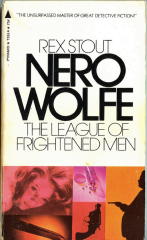
Pyramid, paperback reprint; 1st printing, Oct 1963 [Green Door Mystery]; 5th printing, Jan 1972 (shown). Serialized in The Saturday Evening Post, June 15 to July 20, 1935, as “The Frightened Men.” Hardcover first edition: Farrar & Rinehart, 1935. Cassell, UK, hardcover, 1935. Other paperback reprints include: Avon, 1942; Jonathan Press Mystery #J-33, n.d., digest, abridged; Mercury Mystery #48,n.d., digest, abridged; Jove, June 1979; Bantam, January 1995; Bantam (with Fer-de-Lance), 2008, trade ppbk.
While I can’t tell you either the day or the month, I can tell you exactly what year it was that I read The League of Frightened Men the first time. It was 1955. The reason I can be so sure about this is because I’d just joined the Dollar Mystery Guild, and one of the first selections they sent me was Full House, an omnibus volume containing two Nero Wolfe novels and a collection of short stories, and it was absolutely marvelous.
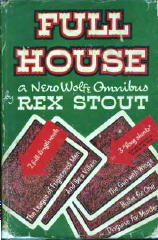
The other novel was And Be a Villain (1948) and the collection was Curtains for Three (1951) — I know because I just looked it up, as otherwise details like these I hadn’t remembered. While I can’t tell you how long it took me, what I do recall is reading the book through from cover to cover. It was as if a new world of detective fiction had opened up to me. (I still have the book today.)
It was the first time, perhaps, that I’d found the characters in a detective novel to be actual people, including the detectives, especially in contrast to the more one-dimensional ones found in, say, the Perry Mason novels, as perfect as puzzle mysteries his books were to me back in 1955.
Not that at the age of thirteen I really knew this was what it was that was different about the Nero Wolfe stories. At that age I’d barely begun to realize that a reader was allowed to have critical opinions about the books they read or the TV shows they saw.
Time passes. This past week it was that I read The League of Frightened Men for the second time, and while I did not remember first of all, who did it, some of the major plot points did come back to me. The byplay between Nero Wolfe and Archie Goodwin, his assistant and number one leg man, came back of course, as that is the probably the number one reason that the Nero Wolfe novels are still read today.
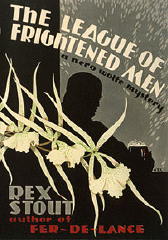
But the villain of the piece, Paul Chapin, the crippled genius the League is so frightened of, he was scary then, and he was still scary to me today. Permanently disabled because of an undergraduate Harvard prank, he’s the center of attention any time he’s on stage (so to speak), and it is no wonder when members of the so-called League of Atonement begin to die or disappear under suspicious circumstances, it is assumed at once that Chapin is responsible, and they call on Wolfe for help.
The verses the members have received do not help. Here’s the first verse of the first one, sometime else that came back to me right away, after a gap of over 50 years from the first time I read it:
Ye should have killed me, watched the last mean sigh
Sneak through my nostril like a fugitive slave
Slinking through bondage.
Ye should have killed me.
Ye killed the man,
Ye should have killed me!
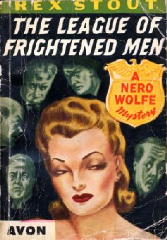
Powerful stuff, as I say, then and now. Maybe overly melodramatic? You might say so, but I’d beg to differ. It’s perfect for the novel and the resulting case for Wolfe and Archie, and perfect for me.
The League of Frightened Men (1935) was the second of the Nero Wolfe novels. The first was Fer-de-Lance (1934) — the final one being Family Affair in 1975 — and not all of the characterizations were set in stone at this early date, although many of Wolfe’s many eccentricities had already been established: his rigid schedule, his aversion to leaving his home for the outside world (although he does in League and more often, I suspect, than his reputation would suggest), the orchid room upstairs, and so on.
I am not sure how someone born after 1975, that being the date of his last appearance, would react to Nero Wolfe if he or she would happen to read one of his detective stories today, especially an early one like League.
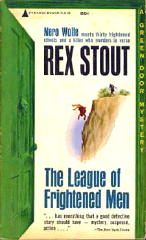
I called Rex Stout’s characters “actual people” a while ago, and while he’s an exaggeration, no doubt, I have no problem envisioning someone like Wolfe living the way he does and acting the way he does.
His adventures certainly wouldn’t have been as successful, though, without Archie to bring him back down to earth when the story needs it, and Archie, while he’s more than sharp enough in many ways, I just can’t picture him being given center stage and a case to solve on his own.
League is a long book, perhaps a little too long, and the pace sags noticeably in the middle. Wolfe often knows things that neither the reader nor Archie does not, or at least not right away. In 1955 I thought this was a wonderful book, but I can see now why it may not be one for the novice Rex Stout reader to start off with.
On the other hand, why not? The water’s fine, the images are sharp, the people detailed, and with the few caveats I’ve just stated, it’s still a terrific job of storytelling.
July 27th, 2008 at 1:03 pm
I agree with you about the Nero Wolfe series, they are excellent and fun to read. Unlike you, I did not discover the books in 1955 when I was 13. I came across them in the Fort Dix hospital library when I was 24 in 1966. During basic training and advance infantry training, I was admitted several times for upper respiratory infections. The only thing that got me through the combination training and hospitalization, was the Nero Wolfe stories that I read. I liked the short novels also that were published three to a book. I believe I have all the books in paperback and still reread one now and then. Ah nostalgia!
July 27th, 2008 at 1:38 pm
Rex’s Nero is an acquired taste although people of a certain age easily acquire it. Younger people seem to find him tedious and pretentious. To me that was the charm of the books.
July 27th, 2008 at 6:26 pm
Walker, You’re right. After a lifetime of reading books and magazines, there’s often a lot of nostalgia that’s involved. The right reading material revisited at the right time can bring back a lot of memories.
Some vintage paperbacks, Shell Scott mysteries for example, can take me back to the supermarket three blocks from my home and the spinner rack where I saw them for the first time.
— Steve
July 27th, 2008 at 6:29 pm
Patti,
Wolfe tedious and pretentious? Pfui.
Times change, I know, but it’s sad.
Best
— Steve
July 8th, 2016 at 12:24 pm
This was the first one I read, then Fer-de-Lance. No matter, I loved the characters of Wolfe and Goodwin, and though the solution is just a bit too “clever” here, it’s early in the day for Stout’s Wolfe writing.
When Patti said there would be a Rex Stout Day on Friday Forgotten, I went to my lists and was surprised at how many Wolfe books remained to be read, though they are right there on the shelf. I’m going to read another as soon as I clear the backlog of books from the library & such.
July 8th, 2016 at 12:56 pm
Even though this review was posted almost eight years ago, everything I said about this book still goes. Thanks to Patti for choosing it for today’s Forgotten Friday tribute to Rex Stout, Nero Wolfe and Archie Goodwin:
http://pattinase.blogspot.com/2016/07/fridays-forgotten-books-rex-stout-day.html
October 17th, 2024 at 2:38 pm
[…] Irresponsible ReaderMystery FileOnly DetectTipping My Fedora – spoiler-y […]